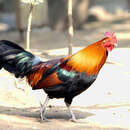en
names in breadcrumbs


Gallus gallus can live up to ten years. The molting process, taking the old feathers and putting new ones on, for an adult, takes about three to four months every year. The memory of the red junglefowl is very short. (North and Bell 1990)
Domestic chickens, Gallus gallus domesticus, are believed to have originated from a continental population of Gallus gallus gallus.
Perception Channels: visual ; tactile ; acoustic ; chemical
Red junglefowl have been mostly genetically interbred with domestic and feral chickens, as a survey of 745 museum specimens has shown. A sign of pure wild genotypes for G. gallus is, for males, an eclipse plumage. This eclipse plumage has been seen only in populations in the western and central of the species' geographic range. It is believed that G. gallus has disappeared from extreme south-eastern Asia and the Phillippines. This suggestion is supported by an intense scientific collection made in 1860. In the 1960's, studies in north-eastern India revealed a population of red junglefowl exhibiting the eclipse plumage. The purity of the species is in danger because of the region's dense human population, whose domestic chickens could continue to contaminate G. gallus genetically. (Peterson and Brisbin 1999)
US Federal List: no special status
CITES: no special status
IUCN Red List of Threatened Species: least concern
Gallus gallus is such an easy animal to take care of and can find food for himself that it does not have a negative impact on economy or humans. (Limburg 1975, Phillips 1999)
These birds are used mainly for eggs and meat production. The red junglefowl is sometimes used for cock fighting or chicken competitions. Gallus gallus feathers were used for pillows and mattress. (Limburg 1975, Peterson and Brisbin 1999)
Gallus gallus is an herbivore and insectivore. Red junglefowls eat corn, soybean, worms, grass, and different kinds of grains found on the ground. They cannot detect sweet tastes. They can detect salt, but most red junglefowl do not like it. (Damerow 1995, Limburg 1975, Ponnampalam 2000)
Gallus gallus is native to Southern Asia, particularly the jungles of India. Gallus gallus spread all over the world when people domesticated the chicken. This account primarily discusses the wild species (Philips 1999, Stevens 1991, Peterson and Brisbin 1999)
Biogeographic Regions: oriental (Native )
Gallus gallus lives in thick secondary forest or lush belukar. In the morning or evening, the bird can be found in an open area by wide earthen tracts or clearing, where the red junglefowl finds food. Sometimes G. gallus can be seen in oil-palm estates. (Ponnampalam 2000)
Terrestrial Biomes: forest
Average lifespan
Status: captivity: 30.0 years.
Gallus gallus' plumage is gold, red, brown, dark maroon, orange, with a bit of metallic green and gray. There are also some white and olive feathers. Two white patches, shaped like an ear, appear on either side of the head. Gallus gallus can be distinguish from other chickens not only by these white patches, but also by the grayish feet. The red junglefowl can measure up to 70 centimeters in length. They have a total of fourteen tail feathers. Gallus gallus rooster tails can be almost 28 centimeter in length.
The red junglefowl rooster is said to be more brilliantly colored that its tame relative. During June to October, G. gallus moults into an eclipse plumage. An eclipse plumage is, for male, black long feather across the middle of his back and slender red-orange plumes on the rest of his body. For a female, an eclipse plumage cannot be distiguished, but she does moult. The female red junglefowl is leaner than tame hens. (North and Bell 1990, Ponnampalam 2000, Stevens 1991, Peterson and Brisbin 1999)
Other Physical Features: endothermic ; bilateral symmetry
Average mass: 2580.2 g.
Average basal metabolic rate: 6.005 W.
The breeding season of the red junglfowl is spring and summer. The chicks will start their lives in the warmth of the summer sun. An egg is laid each day. For twenty-one days before hatching, the chick will develop inside of the egg. On the first day, the heart and blood vessels of the chick develop and start to work. At the end of the first day, the head starts to take shape. By the fourth day, all organs of the future chick are present. On the fifth day, external sex structure developed. By the thirteenth day, the skeleton begins to calcify using the calcium from the eggshell. From the time when the egg is laid until hatching, the chick feeds on the yolk that surrounds him. The yolk penetrate in the chick body by the umbilicus. On the twenty-first day, the chick, now fully developed, starts to break through his thin shell. This action can take anywhere from ten to twenty hours. (North and Bell 1990)
By four to five weeks of age, the chicks are normally fully feathered. Their first adult wings' feather will take another four weeks to grow. When the chicks are twelve weeks old, the mother chases them out of the group. They will then go on to form their own group or join another. At five months old, the chicks reach sexual maturity. The females reach sexual maturity a little later than the males. (Limburg 1975)
Key Reproductive Features: iteroparous ; gonochoric/gonochoristic/dioecious (sexes separate); sexual ; oviparous